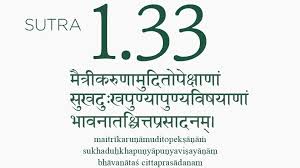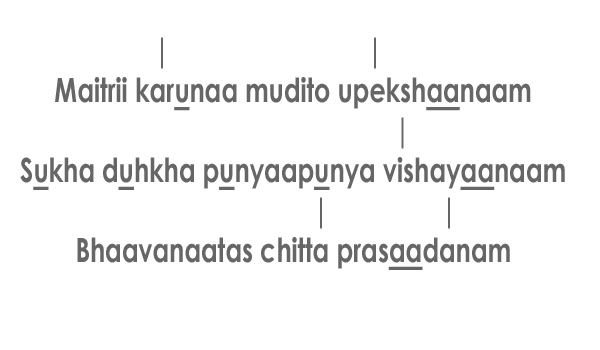Namaste!
Welcome to your wellbeing centre
Celebrating 21 years of serving the Adelaide Yoga community
Yoga Sutra I:33

The Yoga Sutras of Patanjali was the very first codification of yoga and sets out the yogic path. It is created in four parts, books or "pada". Each sutra is a short thread or aphorism (the word "sutra" is related to our English word "suture", the thread the surgeon uses to close a wound).
Sometimes these sutras can be taken as a group for study, or sometimes just a single sutra can give scope for endless reflection and meditation.
In the first pada, sutra 33 is one such sutra that can be reflected on, by itself, quite endlessly.
Patnajali is laying out the ways in which we can follow the path of yoga, and in this sutra he bids us to cultivate the four great attitudes of the heart, friendliness or loving kindness, compassion, joy for others, and equanimity, as the pathway to peace and happiness.
The words are:
This is written so that when a syllable should be pronounced long, it is spelt with a double letter. Otherwise pronounce it short. It is also notated for chanting. More on that later but first to the meaning. Here is the break down of each individual word.
Maitri = friendliness, loving kindness
Karuna = compassion, great love
Mudito = sympathetic joy, gladness
Upekshanam = equanimity
Sukha = happiness, those who are happy
Duhkha = sorrow, those who are suffering
Punya = those who are virtuous
Apunya = those who are malevolent
Vishayanam = Objects, persons
Bhavanatah = feelings, attitudes
Chitta = mind
Prasadanam = purification
And if you put this together you can arrive at a translation something like this:
Loving kindness and friendliness towards the happy, compassion for the sorrowful, joy for others and equanimity, or being undisturbed by events and not being drawn into judgement or contempt are the four attitudes that will bring peace of mind.
This sutra is lovely when chanted, so much that it becomes mesmerising and it is as if the words and meaning are installing themselves in the heart. So included here is a recording as an mp3 so you can learn to chant it too. There are just three notes. In the words of the sutra above, when there is a vertical line above the syllable, it goes up a tone, and when there is a line beneath a syllable, it goes down a tone.
Why not give it a go.
The voice on this recording is that of Tina Shettigara.
(Author, Tina Shettigara)

Get Directions
Contact Us
Yoga Spirit Studios
194 Henley Beach Rd
Torrensville SA 5031
Phone: (08) 8352 7823
Email: info@yogaspirit.com.au
